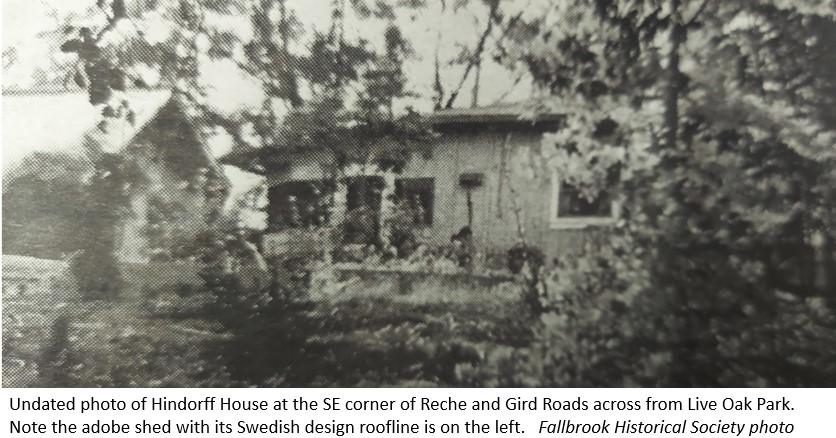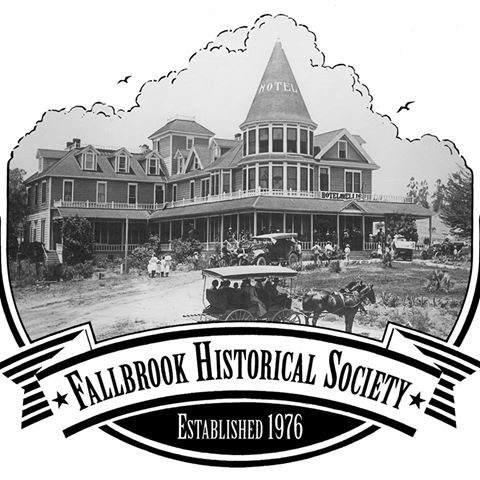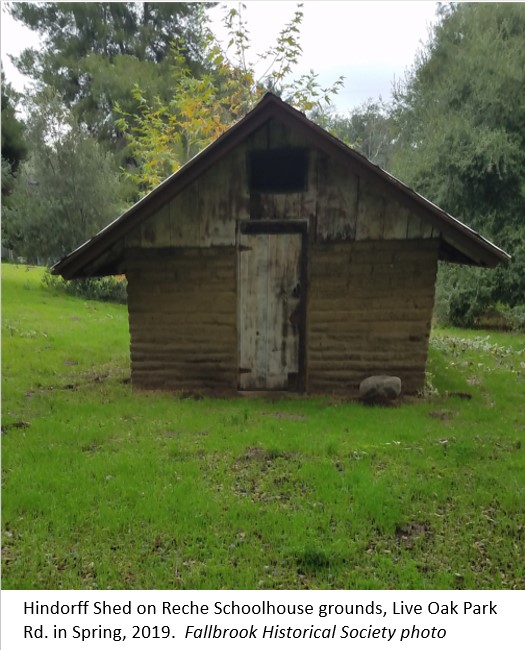An old adobe shed standing on the grounds of the Reche schoolhouse is a legacy of the Hindorff family, Fallbrook pioneers. The adobe was built in the 1920s by Eric Hindorff, the son of a Swedish immigrant and harness maker.
Eric Hindorff was a wolf trapper, an olive tree farmer, a bee inspector, a carpenter, an outdoorsman and a popular violin player at early Fallbrook community gatherings. Born in Iowa, Eric was just an infant when he traveled with his family on a ten day train ride from Iowa to Temecula in 1883.[1]
The Hindorff family took over an abandoned homestead in Rainbow about where the Southbound I-15 truck scales are today. After Eric’s father Gus died of tuberculosis a few years later, Eric’s mother Lenore completed the homestead requirements.[2]
The Hindorff siblings attended Vallecitos elementary school. When they were older, their mother Lenore moved the family into a West Fallbrook home on Pico Ave so the kids could attend Fallbrook High School.[3] Eric didn’t finish school as he worked odd jobs supporting the family. Eric’s sister Dora and her husband, Charles Stubblefield, took over farming the Rainbow homestead.
In 1911, Eric married Pearl Bell at the Fallbrook Methodist Church. Pearl was the daughter of another early Fallbrook family. Eric and Pearl settled on their bee apiary on Reche Road near where Atkins nursery is located today. Shortly afterwards, their home, the apiary and all of their belongings were lost in a fire.
After the fire, Eric and Pearl moved into a tent on another piece of property he owned near Reche’s Grove, at today’s SE corner of Reche and Gird. Hindorff worked urgently to build a new home with used lumber that came from the old Fallbrook hotel recently torn down.[4] About 40 of the couple’s friends gathered to shower them with household goods and clothing they sorely needed.[5]
Hindorff had bought this property using money he earned from the sale of a small tourmaline mine near Rincon that he had discovered and claimed. Pearl died young of complications from pneumonia, leaving him with three small children. Eric then re-married to Annie Lamb who bore three more children. Annie raised all six children as her own.
Besides his own farming and bee keeping, Eric Hindorff worked as a government trapper to hunt wolves, coyotes and even rattlesnakes. He dug wells for other farmers, worked with the County to build some of the earliest roads around Fallbrook. Having experience with concrete, Eric built some of the first sidewalks on Main Ave replacing boardwalks in Fallbrook.[6] After the Reche and Lamb families donated land for a park, Hindorff became the first caretaker of the future Live Oak Park.
In the 1920s, needing a cool place to store canned fruit along with the tomatoes, grapes and berries grown on his property, Eric Hindorff constructed a Spanish-Indian type adobe for a storage shed adjacent to the Hindorff home,[7] but using a design for the roofline and eaves much like those of buildings found in his father’s native Sweden. Eric also used the adobe shed to store the Native American artifacts he found in the area. Some of these items are now on display at the Historical Society Museum.

Adobe buildings once commonly dotted the landscape in Southern California and around old Fallbrook. Adobe buildings were very practical to build in semiarid places where wood and lumber are scarce. Adobe bricks were made by combining naturally occurring clay with sand and organic material like straw or dung to bind the bricks while drying. The adobe mixture was pressed into simple wooden forms to shape bricks, which then were left to dry in the sun for several days. Bricks had to be wide enough to support a roof. The thick walls help keep the interior cool. Constructing adobe bricks is labor intensive, but material is cheap as they are made of dirt and sunshine. [8]
The historic adobe stood next to the Hindorff family home for over 90 years. In 2016 new owners were thinking of demolishing the old adobe shed. Hindorff’s granddaughter, Teddie Anne Driggs, interceded to rescue the historic adobe. The new owners allowed the Fallbrook Historical Society time to obtain funding to dismantle the adobe piece by piece and to move it up the road to the Reche schoolhouse grounds on Live Oak Park Rd, where this piece of Fallbrook’s history was reconstructed just one mile away from where it once stood.

1) Pioneer Family, The Hindorffs page 1, by Margaret Hindorff Ray, May 2001 a memoir at Fallbrook Historical Society.
2) Images of America, Fallbrook, by Rebecca Farnbach and Loretta Barnett page 68, as told by Margaret Hindorff Ray, Eric’s daughter.
3) 1910 U.S. Census.
4) Pioneer Family, The Hindorffs page 2, by Margaret Hindorff Ray, May 2001 a memoir at Fallbrook Historical Society.
5) Fallbrook Enterprise, July 1st, 1911.
6) Pioneer Family, The Hindorffs page 3, by Margaret Hindorff Ray, May 2001 a memoir at Fallbrook Historical Society
8) Are Adobe Houses Sustainable? by Maria Marabito, Treehugger magazine March 11, 2022





